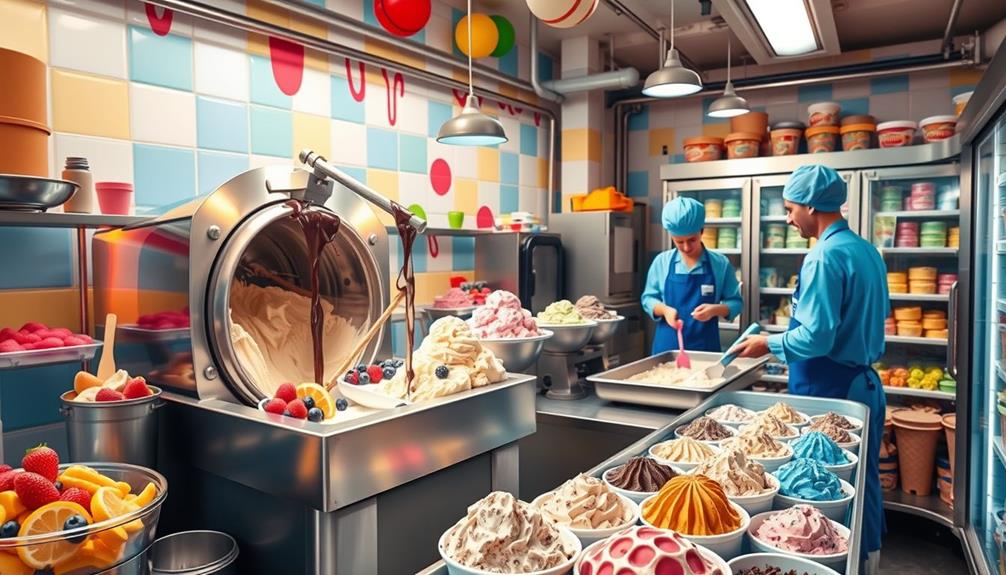Making ice cream involves mixing essential ingredients like milk, cream, sugar, and stabilizers. First, you blend dry and liquid elements, then heat the mixture to eliminate bacteria through pasteurization. Next, you homogenize to create a smooth texture. Cooling and aging enhance creaminess, followed by rapid freezing while churning to incorporate air. This vital step increases volume and helps prevent large ice crystals, maintaining that delightful creamy mouthfeel. Finally, flavors and additional ingredients can be added. If you're curious about different types or innovative methods in ice cream production, there's much more to discover! Additionally, understanding the science behind ice cream production can also help answer common questions, like “can you refreeze ice cream?” While it’s generally not recommended to refreeze ice cream after it has melted, there are some innovative methods and recipes that can help maintain the texture and flavor if you do decide to refreeze it. Exploring the world of ice cream production can lead to new and exciting ways to enjoy this beloved frozen treat.
Key Takeaways
- Ice cream production begins with blending dry ingredients like sugar and stabilizers with liquid components such as milk and cream.
- The mixture is pasteurized at 82-85°C for 15 seconds to eliminate harmful bacteria and ensure safety.
- Homogenization follows, reducing fat droplet size for a smoother and more stable texture.
- The mixture is cooled and aged for 12-24 hours to enhance creaminess before rapid freezing.
- During rapid freezing, air is incorporated, increasing volume and preventing large ice crystals for a creamy texture.
Ice Cream Ingredients
When you think about ice cream, the delicious blend of flavors and textures comes to mind, and it all starts with a few key ingredients. The foundation of ice cream includes milk fat and milk solids, which provide that creamy richness you love. Typically, ice cream contains about 10%-16% fat and 3% protein, contributing to a smooth texture.
Sugars, like cane sugar or glucose syrups, enhance sweetness while lowering the freezing temperature, making your scoop even more enjoyable. In addition to these ingredients, incorporating high nutrient intake elements can elevate the health profile of your ice cream.
To achieve that perfect mouthfeel, stabilizers such as gelatin or vegetable gums are added. They help maintain a uniform texture and control the melting rate, preventing unsightly ice crystals from forming. Emulsifiers play an essential role, too, keeping the emulsion of fat and water stable, ensuring every bite is silky and satisfying.
Flavorings, ranging from chocolate and vanilla to fruit and nuts, are crucial for creating the diverse varieties you adore. Sometimes, egg yolks are included for added richness and improved emulsion.
With total solids ranging from 35% to 42%, these ingredients come together to create the irresistible treat we all crave.
Production Process

After gathering the right ingredients, the ice cream production process kicks off with a careful blending of dry components like sugar and stabilizers with liquid elements such as milk and cream. This mixture can be enhanced by incorporating natural flavors, reminiscent of how vital oils can enhance mood.
Then, you pasteurize the mixture at 82-85°C for 15 seconds, effectively eliminating harmful bacteria. This step is essential for safety and quality.
Next, the mixture is homogenized to reduce fat droplet size, ensuring a smooth and stable texture. Following this, you cool and age the mixture for 12 to 24 hours, allowing fat crystallization to occur, which enhances the final product's creaminess.
The exciting part of ice cream production happens during rapid freezing, where the mixture is chilled to -7°C while agitating to incorporate air. This process increases the volume by 60% to 100% and prevents the formation of large ice crystals, which is key for a desirable texture.
Importance of Air

Air plays an essential role in the ice cream-making process, greatly impacting both texture and flavor. During the freezing process, proper air incorporation can increase your ice cream's volume by 60% to 100%. This boost is vital for achieving that light and smooth ice cream texture you love.
When air is adequately incorporated, it helps prevent the formation of large ice crystals, ensuring your treat remains creamy and enjoyable. Additionally, many vegan ice creams utilize innovative ingredients to enhance texture while remaining animal product-free, making them a delicious option for those following a plant-based diet vegan alternatives.
Churning during freezing not only introduces air but also aids in even flavor distribution throughout your ice cream. If there's insufficient air, your ice cream might end up too hard and difficult to scoop, ruining the overall eating experience.
You'll find that well-aerated ice cream melts more slowly, improving its serving quality. This slower melting rate means you can savor each bite without the rush of a puddle forming beneath your cone.
Nutritional Information

Understanding the nutritional information of ice cream helps you make informed choices about your favorite treat.
Standard vanilla ice cream contains about 2.1g of protein, 5.9g of fat, and 11.5g of carbohydrates, providing 447kJ of energy per serving. If you're looking for a lighter option, reduced-fat vanilla ice cream offers 1.9g of protein, only 1.5g of fat, and 16.0g of carbohydrates, which results in 351kJ of energy.
On the other hand, gelato typically has a denser nutritional composition, featuring 2.2g of protein, 2.6g of fat, and a whopping 26.9g of carbohydrates, contributing 570kJ of energy.
Ice cream is primarily made up of 55%-65% water, along with 3% protein and 10%-16% fat, which all play crucial roles in its mouthfeel and overall nutritional profile.
Keep in mind that the nutritional composition can vary greatly based on the type you choose, influenced by factors like fat content, added sugars, and flavorings.
Innovations in Ice Cream

Ice cream production has come a long way, thanks to exciting innovations that've transformed how this beloved treat is made. One major advancement is the use of continuous freezing methods, which efficiently incorporate air, leading to a smoother texture and a product volume increase of 60% to 100%.
The introduction of soft serve ice cream, pioneered by Dairy Queen, serves this creamy delight at a higher temperature of 18°F, enhancing flavor release and texture.
Modern refrigeration technology has bolstered these developments, while new emulsifiers and stabilizers improve texture and prevent ice crystal formation, ensuring a creamier end product.
Additionally, the rise of plant-based ice cream alternatives caters to the growing demand for vegan and dairy-free options, without sacrificing quality or taste.
Companies like Ben & Jerry's emphasize using all-natural ingredients and unique flavor combinations, producing around 320,000 pints daily.
This trend showcases the industry's shift toward transparency and creativity, allowing you to explore a diverse range of cream products.
With these innovations, ice cream production isn't just about taste; it's about creating an experience that satisfies every palate.
Frequently Asked Questions
How Is Ice Cream Made Step by Step?
To make ice cream step by step, you blend ingredients, pasteurize to eliminate bacteria, homogenize for texture, age the mixture, freeze while agitating to incorporate air, and finally harden it for the perfect consistency.
How Is Ice Cream Made in the Old Days?
Did you know that in the 19th century, making ice cream could take hours of churning by hand? You'd mix ingredients and rely on ice from lakes, transforming labor into a delightful, creamy treat.
What Is Real Ice Cream Made Of?
Real ice cream's made from milk or cream, non-fat solids, and sugars. You'll find flavorings like vanilla or chocolate, plus stabilizers for texture. Occasionally, egg yolks enhance creaminess, giving it that rich, delightful taste.
How Is Milk Turned Into Ice Cream?
To turn milk into ice cream, you blend it with cream, sugars, and flavorings. Then, you pasteurize and homogenize the mixture before cooling and freezing it, incorporating air for that creamy, smooth texture you love.
Conclusion
As you savor a scoop of ice cream on a hot summer day, remember that each creamy bite is a result of careful craftsmanship. Just like a symphony, where every instrument plays an essential role, the blend of ingredients and air creates that perfect texture and flavor harmony. So, the next time you indulge, think of it as a little celebration of science and creativity—a sweet melody you can taste!










